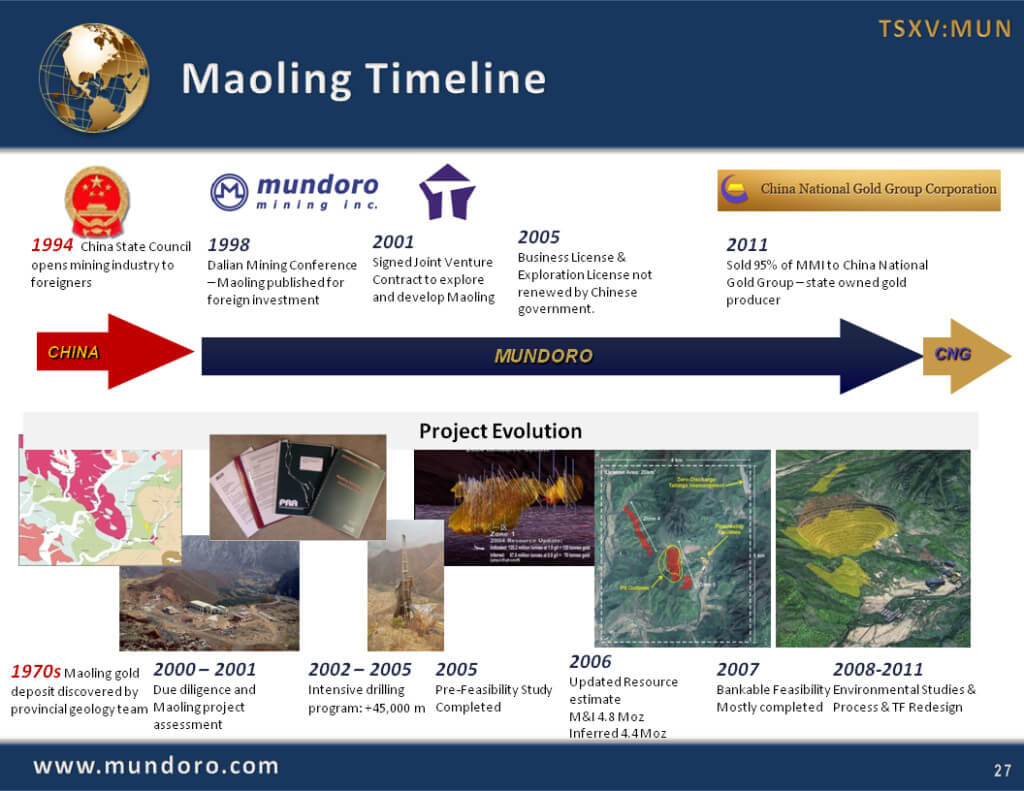Category: Equity investments
History
2010
Throughout 2010, Mundoro continued its efforts to communicate with the Liaoning government and the Company’s joint venture partner regarding the status of Tianli’s business license for the future development of the Maoling Gold Project. The Company attempted to attain a resolution that involved either: a strategic transaction with a Chinese group; receiving the necessary licenses to develop the Maoling Gold Project directly; or obtaining compensation from the relevant Chinese government. The Company also evaluated legal alternatives in China.
The Company was in negotiations and various levels of due diligence with a Chinese publicly listed company, a Chinese state-owned company, and other companies in order to determine if a strategic transaction could be structured such that the Chinese group would acquire the Maoling Gold Project and the Company would retain a minority interest or a form of participation in the event the Maoling Gold Project is developed in the future. Despite the Company’s best efforts, the Joint Venture’s business license and exploration license were not renewed and the Maoling Gold Project remains stalled.
2009
In May 2009, a study titled “A Technical Evaluation Study on Production Process of the Maoling Gold Project” was issued by Guojie Senior Professors Science and Technology Consultation and Development Academy, Department of Environmental Science and Engineering, Tsinghua University in Beijing (“May 2009 Production Process Study”) indicating that the Maoling Gold Project can be developed as per the Feasibility Study (as defined below “2008”) and treated in China as an example of an eco-industrial system for the gold industry.
In the third and fourth quarters of 2009, as part of the evolving Chinese regulatory framework, particularly with respect to cyanide management and Chinese tailings regulations, Mundoro Mining commissioned Ausenco International Pty Ltd (“Ausenco”) and Golder Associates (“Golder”) to prepare a series of studies related to the Maoling Gold Project processing plant and waste storage facilities. It is anticipated that if the Joint Venture’s business license is renewed, the studies will be used in the future towards completion of the Feasibility Study.
The Ausenco study, completed in the fourth quarter of 2009, dealt with a modification to the process flowsheet to incorporate a flotation circuit. The test work on the flotation and Carbon in Leach (“CIL”) route achieved an overall recovery acceptably close to the levels achieved in the original CIL-only circuit. By incorporating the flotation circuit, the use of cyanide would be reduced on a kilogram per tonne of ore basis.
Ausenco carried out an estimate of comparative capital costs and operating costs for the revised flowsheet, comprising an identical front end of crushing, grinding and gravity circuits, but with the addition of a simple bulk flotation circuit and a smaller CIL and cyanide destruction circuit. The capital cost estimate showed a small reduction compared to the original gravity-CIL circuit previously studied in 2007. The operating cost estimate showed a reduction due mainly to the significant savings in cyanide consumption and the consequent reductions in cyanide destruction reagents.
The first of the Golder studies was to redesign the tailings storage facilities to reflect the flotation–CIL flowsheet completed by Ausenco. The Golder study for the waste storage facilities planned for the Maoling Gold Project demonstrates the flotation tailings could be stored in an unlined tailings storage facility as there is no cyanide in the flotation tailings. Only the CIL tailings, a small proportion of the mass, will require storage in a lined storage facility. Both tailings facilities are designed to be operated as closed circuit facilities and the CIL facility in addition would be zero release with flood event storage capacity exceeding current Chinese regulatory requirements. A surface water and groundwater management plan has been designed by Golder for the construction, operation and closure phases of the Maoling Gold Project. This design would minimize potential effects on downstream surface water systems.
These Golder studies, completed in the fourth quarter 2009, have been evaluated by three Chinese design institutes, in the context of certain Chinese environmental regulations and in comparison with relevant Chinese and international examples as related to downstream water storage issues, a key issue for the Maoling Gold Project. As part of the evaluation, three Chinese design institutes completed in January 2010 a document titled “A Study on Yushi Reservoir Water Source Protection Zoning and Analysis of Impact of Maoling Gold Project on Water Source Protection” (the “January 2010 Water Source Protection Study”) which indicated that the Maoling Gold Project can be developed in a sustainable and responsible manner with no significant impact on the downstream water storage facilities.
In 2009, the Company’s community relations contribution involved two schools within the Gaizhou County. Both schools demonstrated a need for computers to help in the teaching and learning process for their respective students. The Company purchased 50 computers, two servers and two printers for a total donation amount of RMB 257,000. To date, the Company has contributed approximately RMB 750,000 to the local and county communities to support health and educational programs.
2008
In January 2008, Ausenco provided an interim report to the Company on the status of the feasibility study (the “Feasibility Study”). Due to the delays in the renewal of Tianli’s business license, certain portions of the Feasibility Study, such as geotechnical drilling for the final pit slope design in Zone 1 and final Chinese cost estimations, were not completed. Throughout the year, Mundoro Mining focused on government relations for the renewal of the business license for the Joint Venture in China. Continuing with the 2007 community relations program, Mundoro Mining contributed RMB 280,000 (US$41,000) for the upgrade of the Kuangdonggou Medical Clinic and middle school in the form of equipment and supplies.
Resources:
The information presented in this section on the Maoling Gold Project is summarized or extracted from the four technical reports (click here), which were each prepared by independent qualified geological and engineering consulting firms. The reports were prepared pursuant to the provisions of National Instrument 43-101 (“NI 43-101”) and the authors are “Qualified Persons” as defined in NI 43-101. Portions of the following information are based on assumptions, qualifications and procedures that are set out only in the full technical reports. For a complete description of assumptions, qualifications and procedures associated with the following information, reference should be made to the full text of each report.
In February of 2006, a revised resource estimate (the “2006 estimate”) for Zone 1 was conducted by Golder Associates Pty Limited (“Golder”). This study incorporated all drilling data used in previous estimates and also the results from 48 diamond core holes (12,800 metres) drilled in 2005. The 2005 drilling program was focused primarily on in-fill drilling to maximize the Indicated Resource to be considered in the Feasibility Study (“FS”). The 2006 estimate includes a modest volume of material, 4 million tonnes grading 1.31 grams gold per tonne using a cut-off grade of 0.5 grams gold per tonne, in the north central part of Zone 1 that has been classified as a Measured Resource. The 2006 estimate for Zone 1’s Measured and Indicated category shows an increase of 26% over 2004’s Indicated category. The cumulative 2006 estimate at various cut-off grades for Zone 1 are outlined below:
Using 0.5 grams gold per tonne as an economic cut-off grade, the 2006 resource estimate provides an additional 41 million tonnes of Measured & Indicated Resource (approximately 1 million ounces of gold) for consideration in the FS over what was considered in the PFS to define a gold reserve.
The decline in average grade of the Indicated Resource from 0.98 grams gold per tonne in the 2004 estimate to 0.92 grams gold per tonne in the current estimate results primarily from; (a) a more constrained geological model used in the current estimate, featuring four independent domains separated by northeast trending faults, versus two domains used in the 2004 estimate; and, (b) the inclusion of 33 million tonnes of additional material at a lower than average grade from the south end of the deposit.
Aggregating the new resource estimate for Zone 1 with a 2001 resource estimate by AMEC for Zone 4 produces the following Maoling Project Resource Summary:
Pre-feasibility study
The information presented in this section on the Maoling Gold Project is summarized or extracted from the four technical reports (click here), which were each prepared by independent qualified geological and engineering consulting firms. The reports were prepared pursuant to the provisions of National Instrument 43-101 (“NI 43-101”) and the authors are “Qualified Persons” as defined in NI 43-101. Portions of the following information are based on assumptions, qualifications and procedures that are set out only in the full technical reports. For a complete description of assumptions, qualifications and procedures associated with the following information, reference should be made to the full text of each report.
After completion of the PFS in mid-2005, work commenced on the Feasibility Study. The Feasibility Study was not completed since additional geotechnical work was required, but could not be done so long as the Joint Venture did not have a valid business license and exploration license. In early September 2005, Mundoro Mining announced that it assembled a core group of consultants to conduct the Feasibility Study and to assist in the mine permitting process for the Maoling Gold Project. The development team included Ausenco, Golder and ENFI . Golder was responsible for resource modeling and estimation, mine and tailings facility design, hydrology and geotechnical studies and Ausenco was the project manager, finalizing process design and working on costing. The mining plan for this study was based on the Measured and Indicated Resources from the 2006 Resource Estimate. The study used environmental, hydrological, geotechnical and metallurgical data collected from the Maoling Gold Project during 2005. The increase in Measured and Indicated Resources was expected to have a positive effect on the size of the mineable reserve, mine life and overall economics of the Maoling Gold Project.
Consulting Teams
Ausenco Limited (Feasibility Study Process Design and Management) is an international engineering firm which completed major mining project developments around the world and developed a specific mining expertise within China.
Golder Associates Pty Limited (Resource Modeling and Estimation, Mine and Tailings Facility Design, Hydrology and Geotechnical Studies) is an international group of consultants that is a recognized world leader in the design and management of mine tailings storage facilities.
2005 PRE-FEASIBILITY STUDY
In early June 2005, AMEC prepared a technical report in respect of the Pre-Feasibility Study (“PFS”) on the Zone 1 deposit of the Maoling Gold Project. The PFS resulted in a statement of Probable Reserves that is included in the table below:
The PFS considered only the Maoling Gold Project’s Indicated Resources (as defined in NI 43-101) of 120 million tonnes (with grading of 1.0 gram of gold per tonne using a 0.50 grams of gold per tonne (“g/t”) cut-off grade) located in the northern half of Zone 1. The following table highlights some of the conclusions of the PFS(1):

